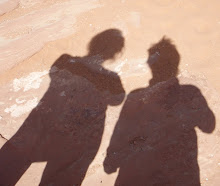I met up with Dustin and Heather in Renmark, SA. Renmark is part of the Riverland, and is known as a citrus and grape producing area. I met them in the evening, and after a dinner at the local pub, we headed out to a cute little cabin at the Australian Landscape Trust's property outside of Renmark for the evening.
It happened to rain most of the night we were there. While this was certainly a good thing for agriculture, it wasn't really so good for driving on unsealed (unpaved) roads. The next morning, we thought we would travel to Wentworth via the backway, which (despite being referred to as a main road in the atlas) is entirely unsealed. We wanted to go to Wentworth because this is where the Darling joins the Murray River. Also, the backway would allow us to see some of the wetlands along the river.
If you've ever done any driving in Australia's Outback, or on any of Australia's unsealed roads, then you would probably know that these roads are generally different than dirt roads in the US. The driving is generally not as easy, and they also tend to be more remote. They can also be difficult to drive on without 4-wheel drive, particularly when they are wet.
We started the drive in South Australia (SA), where the driving was reasonably good, apart from a few big potholes in the middle of the road, which were filled with water, and so difficult to see. However, once we crossed the border and entered New South Wales (NSW), the driving conditions changed drastically. The road actually said that it was closed when wet, and for good reason. It was essentially like driving in thick slush, and the car was unnervingly swerving back and forth. Further ahead, we saw dark clouds which suggested conditions were likely to worsen. So, we decided that we should turn around. Even though it would be a considerable amount of back tracking, we thought that sounded better than getting stranded in a remote part of NSW.
Our decision was the right decision to make. We soon returned to SA and better driving conditions. In fact, they were perhaps too good in comparison to the NSW roads, requiring very little concentration. Unfortunately, on the way back, one of those large potholes I mentioned crept up out of nowhere, and we flew through it at an alarmingly fast speed. The bump startled all of us, and we quickly made sure everyone in the car was OK, which thankfully, we were. Our next thought turned to the car. I thought I heard something stuck in the wheel well, but the sound soon stopped and everything else sounded mostly normal. So we kept driving. We made it back onto the bitumen (pavement) and stopped at the first petrol station to fill up. I got out of the car, and immediately thought something looked funny. I said to Dustin, "Are we missing something?" And he said, "Why yes, our bumper's gone." Just then, a man who pulled up in his ute (pick-up truck) said, "Hey, I saw your bumper back there on the road."
It was a hilarious sight to see, I know, because there were some airport construction workers who were watching us, and couldn't help but laugh. Finally, they asked us if we would like a bucket and some proper rags to clean the car. We readily accepted and did our best to remove the evidence of the car's encounter with the muddy, unsealed road. We were mildly successful, and decided that we might as well just go to the rental car office, which was just on the other side of the parking lot. Oh my.
Fortunately, things settled down noticeably after our first morning. We stayed in Mildura for the evening and had an excellent meeting and a nice dinner with two more individuals who worked for state government departments. The following day, we stopped at one of the icon wetland sites on the way to Deniliquin, a town in NSW where rice is grown. The drive remained interesting however, as we found ourselves on some less traveled roads. My favorite was one that had a strip of pavement down the middle that was only wide enough to accommodate one vehicle. There were dirt strips on either side, but the driving was really much smoother and faster on the pavement. I'm sure everyone who drives on the road, drives on the pavement. However, I'm still not sure about who is supposed to move over onto the dirt when two cars meet. Is it a game of chicken? Does the smaller one yield to the bigger one? Yikes! Let's just say that the two passengers were especially alert during this stage of the driving, our eyes straining to spot any oncoming traffic.
For us, it was a bit strange (but still wonderful) to be here to study drought, and then to see the MDB in flood stage. It will surely be interesting to see what comes in the future, but at least for the moment, the river, the wetlands, the fish, the birds and the plants are all taking a big long drink while they can. For the residents, it's a welcome relief from last year's devastating bush fires. However, the rain is bringing with it some unwelcome consequences, including locust and rat plagues. Apparently, they like the water, too.
Anyways, I was really grateful for the opportunity to see the area that I've been reading about since I arrived, and to get a better sense for Australia's 'food bowl'. It was a short trip, but very instructive and even amusing at times. One thing I can say for sure is that Australians will take poor driving conditions on wet unsealed roads over drought any day. And the Americans just need to adapt and learn how to drive on them!

No comments:
Post a Comment